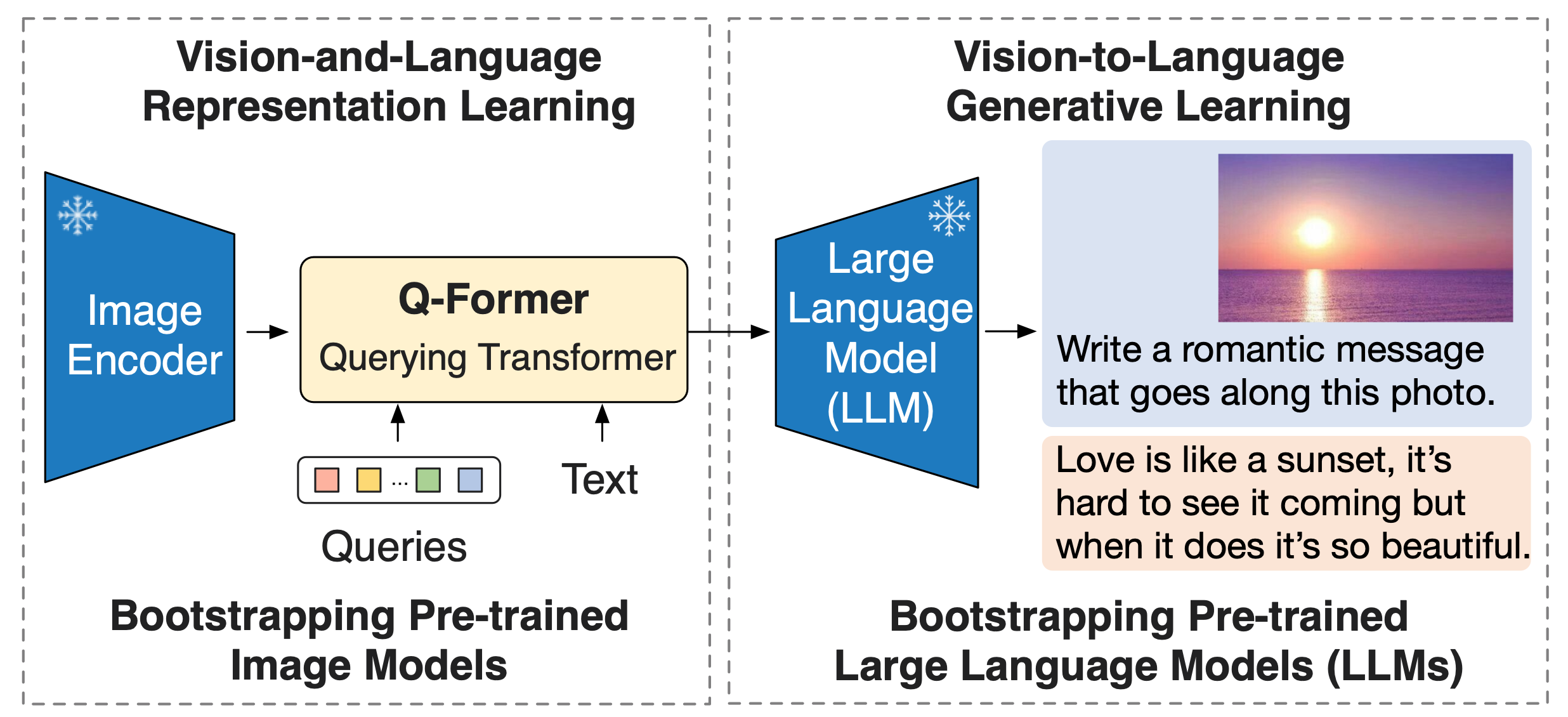BLIP-2: Bootstrapping Language-Image Pre-training with Frozen Image Encoders and Large Language Models
This is the official implementation of BLIP-2 paper, a generic and efficient pre-training strategy that easily harvests development of pretrained vision models and large language models (LLMs) for vision-language pretraining. BLIP-2 beats Flamingo on zero-shot VQAv2 (65.0 vs 56.3), establishing new state-of-the-art on zero-shot captioning (on NoCaps 121.6 CIDEr score vs previous best 113.2). Equipped with powerful LLMs (e.g. OPT, FlanT5), BLIP-2 also unlocks the new zero-shot instructed vision-to-language generation capabilities for various interesting applications!

Install:
pip install salesforce-lavis
or install from source following LAVIS instruction.
Demo:
Try out our Notebook Demo on instructed vision-to-language generation:
BLIP-2 Model Zoo
# ==================================================
# Architectures Types
# ==================================================
# blip2_opt pretrain_opt2.7b, caption_coco_opt2.7b, pretrain_opt6.7b, caption_coco_opt6.7b
# blip2_t5 pretrain_flant5xl, caption_coco_flant5xl, pretrain_flant5xxl
# blip2 pretrain, coco
- Use
pretrained_{LLM}model types for zero-shot image-to-text generation with prompts. - Use
caption_coco_{LLM}model types to generate coco-style captions. - Use
blip2model architecture for image-text feature extraction and retrieval.
Image-to-text Generation Example
Let’s see how to use BLIP-2 models to perform zero-shot instructed image-to-text generation. We first load a sample image from local.
import torch
from PIL import Image
# setup device to use
device = torch.device("cuda") if torch.cuda.is_available() else "cpu"
# load sample image
raw_image = Image.open("../../docs/_static/merlion.png").convert("RGB")
display(raw_image.resize((596, 437)))
Then we load a pre-trained BLIP-2 model with its preprocessors (transforms).
import torch
from lavis.models import load_model_and_preprocess
# loads BLIP-2 pre-trained model
model, vis_processors, _ = load_model_and_preprocess(name="blip2_t5", model_type="pretrain_flant5xxl", is_eval=True, device=device)
# prepare the image
image = vis_processors["eval"](raw_image).unsqueeze(0).to(device)
Given the image and a text prompt, ask the model to generate the response.
model.generate({"image": image, "prompt": "Question: which city is this? Answer:"})
# 'singapore'
Ask the model to explain its answer.
model.generate({
"image": image,
"prompt": "Question: which city is this? Answer: singapore. Question: why?"})
# 'it has a statue of a merlion'
Ask a follow-up question.
# prepare context prompt
context = [
("which city is this?", "singapore"),
("why?", "it has a statue of a merlion"),
]
question = "where is the name merlion coming from?"
template = "Question: {} Answer: {}."
prompt = " ".join([template.format(context[i][0], context[i][1]) for i in range(len(context))]) + " Question: " + question + " Answer:"
print(prompt)
# generate model's response
model.generate({"image": image,"prompt": prompt})
# 'merlion is a portmanteau of mermaid and lion'
Feature Extraction Example
BLIP-2 supports the Unified Feature Extraction Interface of LAVIS. Checkout this notebook for an example.
Image-Text Matching Example
BLIP-2 can compute the image-text matching score using the same interface as BLIP. Checkout this notebook for an example.
Benchmark Evaluation
Follow Dataset Download to prepare common vision-language datasets.
Run these scripts for evaluating pretrained and finetuned models.
Training
Stage-1 Pre-training (from scratch):
bash run_scripts/blip2/train/pretrain_stage1.sh
Stage-2 Pre-training:
bash run_scripts/blip2/train/pretrain_stage2.sh
Finetune for image captioning:
bash run_scripts/blip2/train/train_caption_coco.sh
The config files can be modified for customized training.
Citing BLIP-2
@inproceedings{li2023blip2,
title={{BLIP-2:} Bootstrapping Language-Image Pre-training with Frozen Image Encoders and Large Language Models},
author={Junnan Li and Dongxu Li and Silvio Savarese and Steven Hoi},
year={2023},
booktitle={ICML},
}
🤗 Hugging Face integration
BLIP-2 is integrated into the Hugging Face 🤗 Transformers library, and allows to leverage int8 quanitization thanks to bitsandbytes. This roughly halves the amount of memory required to load the model, without performance degradation.
Documentation can be found here.
Usage in half precision (float16) is as follows:
from PIL import Image
import requests
from transformers import Blip2Processor, Blip2ForConditionalGeneration
import torch
device = "cuda" if torch.cuda.is_available() else "cpu"
processor = Blip2Processor.from_pretrained("Salesforce/blip2-opt-2.7b")
model = Blip2ForConditionalGeneration.from_pretrained(
"Salesforce/blip2-opt-2.7b", torch_dtype=torch.float16
)
model.to(device)
url = "http://images.cocodataset.org/val2017/000000039769.jpg"
image = Image.open(requests.get(url, stream=True).raw)
inputs = processor(images=image, return_tensors="pt").to(device, torch.float16)
generated_ids = model.generate(**inputs)
generated_text = processor.batch_decode(generated_ids, skip_special_tokens=True)[0].strip()
print(generated_text)
To leverage the int8 algorithm, you can run the model as follows:
import torch
import requests
from PIL import Image
from transformers import Blip2Processor, Blip2ForConditionalGeneration
processor = Blip2Processor.from_pretrained("Salesforce/blip2-opt-2.7b")
model = Blip2ForConditionalGeneration.from_pretrained("Salesforce/blip2-opt-2.7b", load_in_8bit=True, device_map="auto")
img_url = 'https://storage.googleapis.com/sfr-vision-language-research/BLIP/demo.jpg'
raw_image = Image.open(requests.get(img_url, stream=True).raw).convert('RGB')
question = "how many dogs are in the picture?"
inputs = processor(raw_image, question, return_tensors="pt").to("cuda", torch.float16)
out = model.generate(**inputs)
print(processor.decode(out[0], skip_special_tokens=True))
All models can be found on the hub.